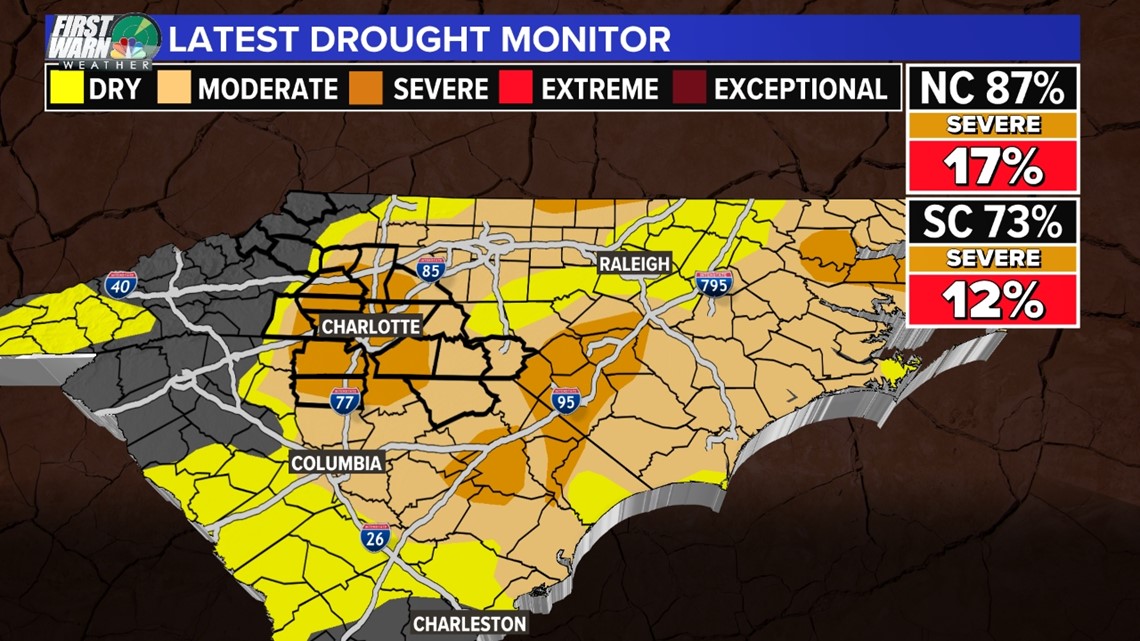CHARLOTTE, N.C. —
Will this week's rain cure the drought?
No, this drought is now the most severe drought the Carolinas have had since 2016.
Drought tends to feed drought. The constant streaks without rain continue to add up and the issue is now starting to become an exponential problem.
This week, there are several rain chances which is a pleasant change from the past few weeks. However, the three main rain producers all look like they won't produce enough and will not be of any significance until the area gets widespread rain.
NOTE: Through December and January, any week that has less than 0.75 inches of rain will worsen drought conditions.
How far behind is the Charlotte area?
As of Dec. 6, 2021, the Greater Charlotte area is around 7 inches below normal for the year. Most of that deficit has been over the last three months.
This autumn was the 18th driest on record, and after a drier summer, the drought is starting to make an impact, which is why Charlotte has been upgraded from a moderate to a severe drought.
Here are the rain totals and deficit numbers since Sept. 1, 2021.
- September: 2.77" (-0.94")
- October: 1.15" (-2.01)
- November: 0,98" (-2.33")
- December (So Far): 0.00" (-0.52")
September was the wettest of the last three months but 1.77" of that 2.77" fell on Sept. 1 alone. Another 0.56" fell on Sept. 22. Around 90% of the rain for the month fell across just three days.
How much rain do we need to recover in 3 months?
In order to remove the Carolinas from an abnormally dry, moderate drought and severe drought, the area needs more than just rain.
Here are the average rain totals over the next three months.
- December: 3.57"
- January: 3.49"
- February: 3.13"
In order to fix this problem within the next three months, the above-average rain totals need to be met plus some. The area below under a severe drought around Charlotte would need to get 5 to 7" above the normal rainfall over the next three months.


That is on top of the average rain. So to cure the drought, the Charlotte area needs 15-17" over rain by the end of February, which could lead to flood problems if it happens all at once.
So every month needs to have above-average rainfall by around 2" to remove us from drought status. The same can be done within 6 months if rainfall averages an inch above normal each month.
When will the burn ban end?
The burn band will continue to be in place until the areas under moderate and severe drought get some desperate rain. This will likely take weeks or until a cold front or low-pressure system brings a few inches of rain over a couple of days. So sit tight, be mindful and don't burn.
Most recent drought monitor:
The updated United States drought has 87% of North Carolina and 73% of South Carolina are under drier than normal conditions.
But the biggest change has been our drought status. It has been upgraded to severe drought or a D2. This isn’t just a small spot, either. It encompasses 17% of North Carolina and 12% of South Carolina. This includes all of Mecklenburg County.
Contact Chris Mulcahy at cmulcahy@wcnc.com and follow him on Facebook, Twitter and Instagram.
Wake Up Charlotte To Go is a daily news and weather podcast you can listen to so you can start your day with the team at Wake Up Charlotte.
SUBSCRIBE: Apple Podcasts || Spotify || Stitcher || TuneIn || Google Podcasts
All of WCNC Charlotte's podcasts are free and available for both streaming and download. You can listen now on Android, iPhone, Amazon, and other internet-connected devices. Join us from North Carolina, South Carolina, or on the go anywhere.

